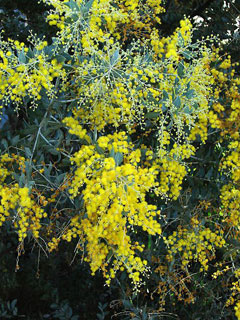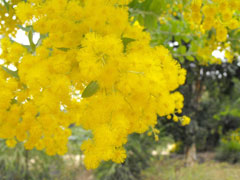 |
|
http://www.flickr.com/people/62938898@N00 |
 |
| http://commons.wikimedia.org/wiki/User:Stickpen |
Translate this page:
Summary
Physical Characteristics

 Acacia podalyriifolia is an evergreen Tree growing to 3 m (9ft) by 3 m (9ft).
Acacia podalyriifolia is an evergreen Tree growing to 3 m (9ft) by 3 m (9ft).
See above for USDA hardiness. It is hardy to UK zone 8. It is in leaf all year, in flower from January to May. The species is hermaphrodite (has both male and female organs).
It can fix Nitrogen.
Suitable for: light (sandy) and medium (loamy) soils and prefers well-drained soil. Suitable pH: mildly acid and neutral soils. It cannot grow in the shade. It prefers dry or moist soil.
UK Hardiness Map
US Hardiness Map
Synonyms
Plant Habitats
Woodland Garden Sunny Edge; South Wall. By. West Wall. By.
Edible Uses
Edible Parts: Flowers
Edible Uses:
Flowers - cooked[144]. Rich in pollen, they are often used in fritters[183]. The flowers have a delicate sweet perfume[245].
References More on Edible Uses
Medicinal Uses
Plants For A Future can not take any responsibility for any adverse effects from the use of plants. Always seek advice from a professional before using a plant medicinally.
None known
References More on Medicinal Uses
The Bookshop: Edible Plant Books
Our Latest books on Perennial Plants For Food Forests and Permaculture Gardens in paperback or digital formats.

Edible Tropical Plants
Food Forest Plants for Hotter Conditions: 250+ Plants For Tropical Food Forests & Permaculture Gardens.
More

Edible Temperate Plants
Plants for Your Food Forest: 500 Plants for Temperate Food Forests & Permaculture Gardens.
More

More Books
PFAF have eight books available in paperback and digital formats. Browse the shop for more information.
Shop Now
Other Uses
Dye Soil stabilization
A yellow dye is obtained from the flowers[168]. A green dye is obtained from the seed pods[168]. When planted on steep slopes or other fragile soil systems, the extensive root system of this plant binds the soil together and helps to prevent erosion[200].
Special Uses
Nitrogen Fixer Scented Plants
References More on Other Uses
Cultivation details
Prefers a sandy loam and a very sunny position[1]. Succeeds in any good garden soil that is not excessively limey[11, 167]. Many members of this genus become chlorotic on limey soils[200]. Can succeed in a hot dry position in a mixed border[166]. Plants are not very cold-hardy, tolerating temperatures down to about -3°c[260]. They succeed outdoors in the mildest areas of Britain, though even there they can be cut back to the ground in severe winters[1, 11]. A very ornamental tree[1], it can be pruned back hard after flowering in order to induce good flowering the following year[260]. This species has a symbiotic relationship with certain soil bacteria, these bacteria form nodules on the roots and fix atmospheric nitrogen. Some of this nitrogen is utilized by the growing plant but some can also be used by other plants growing nearby[200].
References Carbon Farming Information and Carbon Sequestration Information
Temperature Converter
Type a value in the Celsius field to convert the value to Fahrenheit:
Fahrenheit:
The PFAF Bookshop
Plants For A Future have a number of books available in paperback and digital form. Book titles include Edible Plants, Edible Perennials, Edible Trees,Edible Shrubs, Woodland Gardening, and Temperate Food Forest Plants. Our new book is Food Forest Plants For Hotter Conditions (Tropical and Sub-Tropical).
Shop Now
Plant Propagation
Seed - best sown as soon as it is ripe in a sunny position in a warm greenhouse[1]. Stored seed should be scarified, pre-soaked for 12 hours in warm water and then sown in a warm greenhouse in March. The seed germinates in 3 - 4 weeks at 25°c[133]. As soon as the seedlings are large enough to handle, prick them out into individual pots and grow them on in a sunny position in the greenhouse for their first winter. Plant them out in late spring or early summer, after the last expected frosts, and consider giving them some protection from the cold for their first winter outdoors. Cuttings of half-ripe wood with a heel, July/August in individual pots in a frame[78]. Overwinter in a greenhouse for the first winter and plant out in their permanent positions in late spring or early summer. Fair percentage[78].
Other Names
If available other names are mentioned here
Native Range
AUSTRALASIA: Australia (New South Wales (northeast), Queensland (southeast))
Weed Potential
Right plant wrong place. We are currently updating this section.
Please note that a plant may be invasive in one area but may not in your area so it's worth checking.
Conservation Status
IUCN Red List of Threatened Plants Status :

| Related Plants
|
| Latin Name | Common Name | Habit | Height | Hardiness | Growth | Soil | Shade | Moisture | Edible | Medicinal | Other |
| Acacia aneura | Mulga Acacia | Tree | 15.0 |
8-11
| S | LM | N | DM | 3 | 0 | 3 |
| Acacia angustissima | Prairie acacia. Timbre. Fernleaf Acacia | Tree | 5.0 |
7-10
| F | LMH | N | DM | 2 | 3 | 4 |
| Acacia auriculiformis | Ear-Pod Wattle, Black Acacia, Earleaf, Black wattle | Tree | 25.0 |
10-12
| F | LMH | N | DM | 1 | 0 | 4 |
| Acacia catechu | Cutch tree, Catechu acacia | Tree | 15.0 |
10-12
| F | LMH | N | DM | 1 | 2 | 3 |
| Acacia colei | Cole's wattle, Candelabra Wattle, Soap wattle, | Shrub | 4.0 |
10-12
| F | LMH | N | DM | 3 | 2 | 3 |
| Acacia concinna | Shikakai, Soap-Pod | Tree | 10.0 |
10-11
| M | LM | N | D | 2 | 1 | 4 |
| Acacia coriacea | Wiry Wattle, Acacia, Leather Leaf | Tree | 5.0 |
9-11
| M | LMH | SN | DM | 3 | 0 | 3 |
| Acacia cowleana | Hall’s Creek wattle | Tree | 5.0 |
10-12
| F | LM | N | DM | 3 | 2 | 3 |
| Acacia cultriformis | Knife-Leaf Wattle, Knife acacia | Shrub | 4.0 |
9-11
| S | LMH | N | DM | 2 | 0 | 3 |
| Acacia dealbata | Mimosa, Silver wattle | Tree | 25.0 |
7-10
| F | LM | N | DM | 2 | 0 | 3 |
| Acacia decurrens | Green Wattle | Tree | 12.0 |
6-9
| F | LM | N | DM | 2 | 1 | 3 |
| Acacia farnesiana | Sweet Acacia, Perfume Acacia, Huisache | Shrub | 9.0 |
9-11
| F | LMH | N | DM | 2 | 2 | 4 |
| Acacia holosericea | Strap wattle, Candelabra wattle | Shrub | 3.0 |
10-12
| F | LMH | N | M | 1 | 2 | 3 |
| Acacia koa | Koa Acacia | Tree | 20.0 |
10-12
| F | LMH | N | DM | 0 | 2 | 3 |
| Acacia koaia | Koai'a | Tree | 5.0 |
10-12
| F | LMH | N | DM | 0 | 1 | 4 |
| Acacia leucophloea | Kuteera-Gum, White-barked acacia. | Tree | 25.0 |
10-12
| M | LMH | N | DM | 2 | 1 | 3 |
| Acacia longifolia | Sydney Golden Wattle, Acacia | Tree | 9.0 |
10-11
| M | L | N | DM | 3 | 0 | 3 |
| Acacia mearnsii | Black Wattle, Late black wattle | Tree | 10.0 |
8-11
| F | LM | N | M | 1 | 3 | 4 |
| Acacia melanoxylon | Blackwood, Australia Acacia, Black Acacia, Blackwood Acacia | Tree | 30.0 |
9-11
| F | LM | N | DM | 2 | 1 | 4 |
| Acacia mucronata | Narrow-Leaf Wattle | Tree | 9.0 |
7-10
| | L | N | DM | 2 | 0 | 3 |
| Acacia murrayana | Murray’s wattle, Colony wattle | Tree | 5.0 |
10-12
| F | LMH | N | DM | 3 | 2 | 3 |
| Acacia paradoxa | Kangaroo Thorn, Paradox acacia | Shrub | 5.0 |
7-10
| | LMH | N | DM | 1 | 0 | 2 |
| Acacia pycnantha | Golden Wattle | Tree | 8.0 |
7-10
| F | L | N | DM | 2 | 0 | 3 |
| Acacia retinodes | Swamp Wattle, Water wattle | Tree | 6.0 |
7-10
| | LM | N | DM | 2 | 0 | 3 |
| Acacia saligna | Blue-Leaved Wattle, Orange wattle | Shrub | 6.0 |
7-10
| F | LMH | N | DM | 1 | 0 | 5 |
| Acacia sophorae | Coastal Wattle, Acacia | Shrub | 0.0 |
0-0
| | LMH | N | DM | 2 | 0 | 3 |
| Acacia verticillata | Prickly Moses | Shrub | 6.0 |
7-10
| | LMH | N | DM | 1 | 0 | 3 |
| Acacia victoriae | Bramble wattle. Gundabluey, Bardi bush | Shrub | 10.0 |
8-11
| F | LMH | N | DM | 4 | 2 | 3 |
| Arracacia xanthorrhiza | Peruvian Parsnip, Arracacha | Perennial | 1.0 |
8-11
| | M | SN | M | 4 | 0 | 0 |
|
|
Growth: S = slow M = medium F = fast. Soil: L = light (sandy) M = medium H = heavy (clay). pH: A = acid N = neutral B = basic (alkaline). Shade: F = full shade S = semi-shade N = no shade. Moisture: D = dry M = Moist We = wet Wa = water.
Now available:
Food Forest Plants for Mediterranean Conditions
350+ Perennial Plants For Mediterranean and Drier Food Forests and Permaculture Gardens.
[Paperback and eBook]
This is the third in Plants For A Future's series of plant guides for food forests tailored to
specific climate zones. Following volumes on temperate and tropical ecosystems, this book focuses
on species suited to Mediterranean conditions—regions with hot, dry summers and cool, wet winters,
often facing the added challenge of climate change.
Read More
Expert comment
Author
A.Cunn. ex G.Don.
Botanical References
11200286
Links / References
For a list of references used on this page please go here
Readers comment
| Add a comment |
|
If you have important information about this plant that may help other users please add a comment or link below. Only comments or links that are felt to be directly relevant to a plant will be included. If you think a comment/link or information contained on this page is inaccurate or misleading we would welcome your feedback at [email protected]. If you have questions about a plant please use the Forum on this website as we do not have the resources to answer questions ourselves.
* Please note: the comments by website users are not necessarily those held by PFAF and may give misleading or inaccurate information.
To leave a comment please Register or login here All comments need to be approved so will not appear immediately.
|
Subject : Acacia podalyriifolia
|
|
|
|